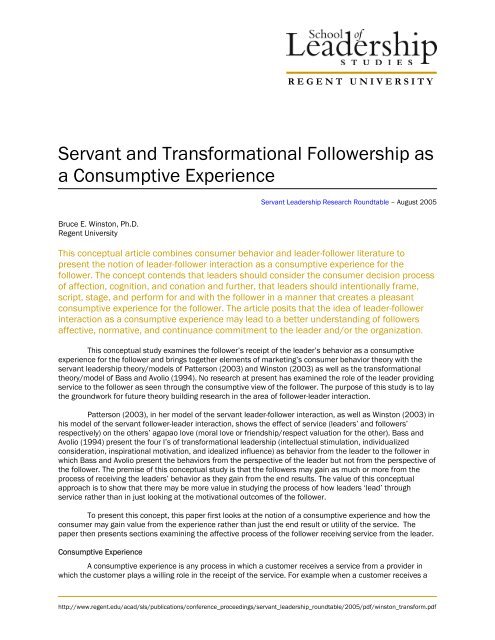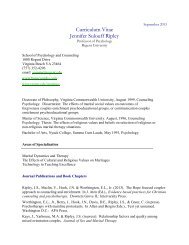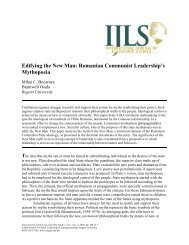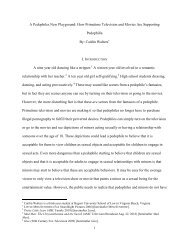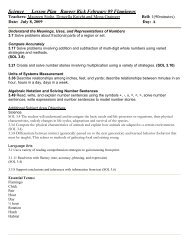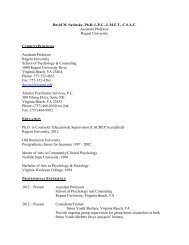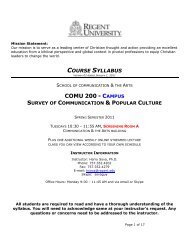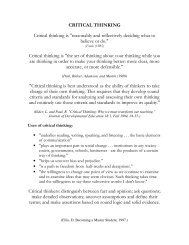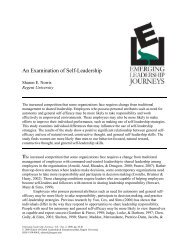Servant and Transformational Followership as a ... - Regent University
Servant and Transformational Followership as a ... - Regent University
Servant and Transformational Followership as a ... - Regent University
You also want an ePaper? Increase the reach of your titles
YUMPU automatically turns print PDFs into web optimized ePapers that Google loves.
REGENT UNIVERSITY<br />
<strong>Servant</strong> <strong>and</strong> <strong>Transformational</strong> <strong>Followership</strong> <strong>as</strong><br />
a Consumptive Experience<br />
Bruce E. Winston, Ph.D.<br />
<strong>Regent</strong> <strong>University</strong><br />
<strong>Servant</strong> Leadership Research Roundtable – August 2005<br />
This conceptual article combines consumer behavior <strong>and</strong> leader-follower literature to<br />
present the notion of leader-follower interaction <strong>as</strong> a consumptive experience for the<br />
follower. The concept contends that leaders should consider the consumer decision process<br />
of affection, cognition, <strong>and</strong> conation <strong>and</strong> further, that leaders should intentionally frame,<br />
script, stage, <strong>and</strong> perform for <strong>and</strong> with the follower in a manner that creates a ple<strong>as</strong>ant<br />
consumptive experience for the follower. The article posits that the idea of leader-follower<br />
interaction <strong>as</strong> a consumptive experience may lead to a better underst<strong>and</strong>ing of followers<br />
affective, normative, <strong>and</strong> continuance commitment to the leader <strong>and</strong>/or the organization.<br />
This conceptual study examines the follower’s receipt of the leader’s behavior <strong>as</strong> a consumptive<br />
experience for the follower <strong>and</strong> brings together elements of marketing’s consumer behavior theory with the<br />
servant leadership theory/models of Patterson (2003) <strong>and</strong> Winston (2003) <strong>as</strong> well <strong>as</strong> the transformational<br />
theory/model of B<strong>as</strong>s <strong>and</strong> Avolio (1994). No research at present h<strong>as</strong> examined the role of the leader providing<br />
service to the follower <strong>as</strong> seen through the consumptive view of the follower. The purpose of this study is to lay<br />
the groundwork for future theory building research in the area of follower-leader interaction.<br />
Patterson (2003), in her model of the servant leader-follower interaction, <strong>as</strong> well <strong>as</strong> Winston (2003) in<br />
his model of the servant follower-leader interaction, shows the effect of service (leaders’ <strong>and</strong> followers’<br />
respectively) on the others’ agapao love (moral love or friendship/respect valuation for the other). B<strong>as</strong>s <strong>and</strong><br />
Avolio (1994) present the four I’s of transformational leadership (intellectual stimulation, individualized<br />
consideration, inspirational motivation, <strong>and</strong> idealized influence) <strong>as</strong> behavior from the leader to the follower in<br />
which B<strong>as</strong>s <strong>and</strong> Avolio present the behaviors from the perspective of the leader but not from the perspective of<br />
the follower. The premise of this conceptual study is that the followers may gain <strong>as</strong> much or more from the<br />
process of receiving the leaders’ behavior <strong>as</strong> they gain from the end results. The value of this conceptual<br />
approach is to show that there may be more value in studying the process of how leaders ‘lead’ through<br />
service rather than in just looking at the motivational outcomes of the follower.<br />
To present this concept, this paper first looks at the notion of a consumptive experience <strong>and</strong> how the<br />
consumer may gain value from the experience rather than just the end result or utility of the service. The<br />
paper then presents sections examining the affective process of the follower receiving service from the leader.<br />
Consumptive Experience<br />
A consumptive experience is any process in which a customer receives a service from a provider in<br />
which the customer plays a willing role in the receipt of the service. For example when a customer receives a<br />
http://www.regent.edu/acad/sls/publications/conference_proceedings/servant_leadership_roundtable/2005/pdf/winston_transform.pdf
2 <strong>Servant</strong> <strong>and</strong> <strong>Transformational</strong> <strong>Followership</strong> <strong>as</strong> a Consumptive Experience - Winston<br />
hair cut, manicure, etc, the customer plays an active role in the receipt of the services. Where<strong>as</strong>, when a<br />
customer receives a newspaper delivered to his or her home the customer benefits from the service but is not<br />
an active player in the delivery of the service. In a consumptive experience the consumer may place more<br />
benefit on the experience of receiving the service than on the end result of the service. For example, the<br />
haircut <strong>and</strong> manicure customer may express satisfaction with a ple<strong>as</strong>urable experience even if the end result<br />
(haircut or manicure) is of lower quality than another provider might provide. And the converse is true <strong>as</strong> well in<br />
that a customer may be dissatisfied with a good haircut or manicure if the process of receiving the service w<strong>as</strong><br />
not ple<strong>as</strong>urable. This relates to the leader-follower interaction in that the follower may <strong>as</strong>cribe more<br />
satisfaction or ple<strong>as</strong>ure with a leader who may be less competent if the process of interacting with the leader<br />
yielded satisfaction to the follower. The converse is also true in that a follower may <strong>as</strong>cribe dissatisfaction with<br />
a competent leader if the interaction with the leader w<strong>as</strong> not ple<strong>as</strong>urable.<br />
To <strong>as</strong>sist in underst<strong>and</strong>ing consumer satisfaction, this conceptual study relies on Geise <strong>and</strong> Cotes’<br />
(2000) conceptual study of consumer behavior <strong>and</strong> accepts Geise <strong>and</strong> Cotes’ evaluation of the literature to<br />
show that consumer satisfaction h<strong>as</strong> three elements: (a) affective, cognitive, or conative responses, (b)<br />
evaluated against p<strong>as</strong>t experiences <strong>as</strong> well <strong>as</strong> the service-related attributes (service delivery person, etc), <strong>and</strong><br />
(c) expressed before, during <strong>as</strong> well <strong>as</strong> after service encounters. Geise <strong>and</strong> Cotes’ interpretation of the<br />
literature on consumer satisfaction applies to the follower’s consumptive experience in that the follower<br />
engages in both affective <strong>and</strong> cognitive interaction with the leader during <strong>and</strong> after the leader-service<br />
exchange <strong>and</strong> the follower compares the leader-service experience against p<strong>as</strong>t experiences. P<strong>as</strong>t experiences<br />
include interaction with the immediate present leader, other present leaders, p<strong>as</strong>t leaders in the organization,<br />
<strong>as</strong> well <strong>as</strong> p<strong>as</strong>t leaders from other organizations.<br />
If leaders see their leader-service to followers from the view of the followers consumptive experience it<br />
may require the leader to consider how his or her behavior is viewed by <strong>and</strong> received by the follower, both<br />
affectively <strong>and</strong> cognitively. This may require the leader to consider the dramaturgical nature of leader behavior.<br />
Gardner <strong>and</strong> Avolio (1998) examined the leader-actor role <strong>and</strong> the follower-audience role of the leader’s<br />
impression management efforts but their study did not focus on the consumption experience of the follower<br />
but rather on the leader’s efforts to portray an image <strong>and</strong> create an impression in the mind of the follower.<br />
However, Gardner <strong>and</strong> Avolio’s work applies to this present study of the follower’s consumptive experience in<br />
that Gardner <strong>and</strong> Avolio show that the leader moves through four ph<strong>as</strong>es of behavior: (a) framing, (b) scripting,<br />
(c) staging, <strong>and</strong> (d) performing with a desired result of having the follower show positive affect to the leader.<br />
What Gardner <strong>and</strong> Avolio leave out is what this present study addresses – the consumptive experience by the<br />
follower that mediates the follower’s affect to the leader. Gardner <strong>and</strong> Avolio build on Conger’s (1989) work on<br />
charismatic leaders in which Conger states that charismatic leaders are meaning-makers <strong>and</strong> to which<br />
Gardner <strong>and</strong> Avolio call for a deeper underst<strong>and</strong>ing of how leaders use dramaturgical behaviors to create<br />
meaning. This present conceptual study adds to this by implying that in addition to meaning-making, the leader<br />
must seek to create consumptive-satisfaction through the leader’s dramaturgical efforts. The leader must<br />
desire this to happen, which leads to the proposition:<br />
Proposition 1: the leader must have an internal value desiring to create satisfaction<br />
for the follower through the leader-follower interaction<br />
Proposition 1 ties well to Patterson’s (2003) model of servant leadership in that the leader is focused<br />
on the follower <strong>and</strong> seeks to produce higher levels of satisfaction in the follower. Winston’s (2003) model of<br />
the follower-leader interaction uses this notion of higher levels of satisfaction to impact the follower’s<br />
commitment to the leader.<br />
Affective Response by the Follower<br />
Gardner <strong>and</strong> Avolio (1998) propose that leaders must consider the needs of the follower <strong>as</strong> the leader<br />
defines the ideal vision where<strong>as</strong> this current study proposes that leaders must underst<strong>and</strong> what the follower<br />
wants <strong>and</strong> needs in terms of affective stimulus in order to have interest in the leader’s vision. This is what the<br />
colloquial ‘platinum rule’ says in that rather than ‘doing unto others <strong>as</strong> you want them to do unto you’ <strong>as</strong> the<br />
‘golden rule’ state the leader should ‘do unto the follower what the follower wants <strong>and</strong> in a manner that the
<strong>Servant</strong> Leadership Research Roundtable – August 2005 3<br />
follower will be satisfied with.” This ties well with Gardner <strong>and</strong> Avolio’s notion of (a) framing, (b) scripting, (c)<br />
staging, <strong>and</strong> (d) performing in that the leader must make intentionally seek to effect the follower. Thus,<br />
Proposition 2: the leader must know the individual desires <strong>and</strong> wants relative to the<br />
leader-follower interaction <strong>and</strong> the leader must intentionally behave towards the<br />
follower in a way that produces satisfaction for the follower.<br />
Proposition 2 is similar to B<strong>as</strong>s <strong>and</strong> Avolio’s (1994) ‘individualized consideration’ but focuses on the<br />
interaction rather than the end-state motivation method. Proposition 2 also ties well to Patterson’s (2003)<br />
model in that the leader’s behavior is b<strong>as</strong>ed on the leader’s ‘agapao’ love for the follower <strong>as</strong> demonstrated<br />
through the leader’s seven values of ‘agapao’ love <strong>as</strong> Patterson’s model shows.<br />
Cognitive Response by the Follower<br />
Although Patterson’s (2003) <strong>and</strong> Winston’s (2003) models of servant leadership do not address<br />
cognitive responses by the follower, per se, there is an implication in the ‘vision’ variable of Patterson’s model<br />
that cognition plays a role. B<strong>as</strong>s <strong>and</strong> Avolio’s (1994) theoretical variable of ‘intellectual stimulation’ would<br />
include cognition <strong>as</strong> well. In Patterson’s variable of vision the leader learns about the follower’s vision <strong>and</strong> then<br />
seeks to modify the organization to allow the follower to accomplish his/her vision. This process presumes that<br />
the follower’s values <strong>and</strong> vision are in line with the organization’s values <strong>and</strong> vision, thus insuring compatible<br />
end-states. For the leader to underst<strong>and</strong> the follower’s vision the leader must engage in meaningful dialogue<br />
with the follower in order to gain a full underst<strong>and</strong>ing of what the follower desires.<br />
B<strong>as</strong>s <strong>and</strong> Avolio’s (1994) notion of intellectual stimulation calls for the leader to stimulate the follower<br />
intellectually such that most the follower <strong>and</strong> leader are lifted to higher states of intellectual discourse. This<br />
requires that the leader know what topics are of interest to the follower, although B<strong>as</strong>s <strong>and</strong> Avolio’s concept<br />
presumes the leader’s interest in the well-being of the organization (B<strong>as</strong>s, 2000 see page 33) <strong>as</strong> compared to<br />
Patterson’s (2003) servant leadership concept where the focus of the leader is on the follower.<br />
The consumptive experience for the follower can be the same regardless if the leader’s focus is on the<br />
organization or the follower <strong>and</strong> requires only that the follower gain satisfaction from the cognitive process. The<br />
follower must be able to note satisfaction during <strong>and</strong> after the exchange <strong>and</strong> be able to identify the cognitive<br />
re<strong>as</strong>ons why the follower enjoyed the leader’s service. The leader can enhance the likelihood of the follower’s<br />
satisfaction through the use of emotional intelligence (Winston & Hartsfield, 2004). According to Mayer <strong>and</strong><br />
Salovey (1997) leaders who use emotion to enhance cognitive processes <strong>and</strong> decision-making use behaviors<br />
such <strong>as</strong> (a) enthusi<strong>as</strong>m, (b) optimism, (c) curiosity, (d) openness to new ide<strong>as</strong>, <strong>and</strong> (e) being responsive to self<br />
<strong>and</strong> others. Adding to the underst<strong>and</strong>ing of the use of emotion, Cooper <strong>and</strong> Sawaf (1996) posit that these<br />
leader-behaviors are antecedents to followers trusting the leader in that follower observe <strong>and</strong> interpret the<br />
behaviors <strong>and</strong> <strong>as</strong>cribe or attribute the behaviors <strong>as</strong> indicative of fairness, consistency, <strong>and</strong> appropriateness.<br />
The follower will sense satisfaction when there is an incre<strong>as</strong>e in the follower’s perception of trust, fairness,<br />
consistency, <strong>and</strong> appropriateness from the leader. Thus,<br />
Proposition 3: the leader must be skilled at the use of emotional intelligence in order<br />
to create intellectual stimulation that results in satisfaction for the follower.<br />
Conative Response by the Follower<br />
Fishbein <strong>and</strong> Ajzen (1975) define conative response <strong>as</strong> representing the underlying intentions of the<br />
person that precipitate the actual behavior. Reid <strong>and</strong> Crompton (1993) applied the idea of conative responses<br />
to the level of involvement of the consumer in making a purch<strong>as</strong>e decision. This present study of leadership <strong>as</strong><br />
a consumptive experience incorporates the notion of conation <strong>as</strong> a key factor in followers’ decisions to follow<br />
the leader. Conation, in consumer behavior, is important because it requires the marketer to use<br />
communication (advertising) to create the intent to purch<strong>as</strong>e in the consumer so that the consumer is ‘sold’<br />
prior to arriving at the vendor’s venue. This current study implies that the leader must focus on using rhetoric<br />
<strong>and</strong> impression management communication to impact the follower’s.<br />
Lavidege <strong>and</strong> Steiner (1961) posited that conation logically followed cognition <strong>and</strong> affection in the<br />
consumer <strong>and</strong> demonstrated this progression in a concept they called the ‘hierarchy of effect’ in which the<br />
consumer moved through the ph<strong>as</strong>es of: (a) awareness, (b) knowledge, (c) interest, (d) preference, (e)<br />
Published by the School of Leadership Studies, <strong>Regent</strong> <strong>University</strong>
4 <strong>Servant</strong> <strong>and</strong> <strong>Transformational</strong> <strong>Followership</strong> <strong>as</strong> a Consumptive Experience - Winston<br />
selection, <strong>and</strong> (f) purch<strong>as</strong>e. Although Geise <strong>and</strong> Cotes (2000) presented affection before cognition, this<br />
present study does not propose an order but acknowledges that all three (a) affection, (b) cognition, <strong>and</strong> (c)<br />
conation must occur for the follower to make a decision to accept the leader <strong>and</strong> to work with the leader.<br />
B<strong>as</strong>s <strong>and</strong> Avolio’s (1994) variables of inspirational motivation <strong>and</strong> idealized influence combine the use<br />
of affection <strong>and</strong> cognition to establish the intent to behave, or conation, in the follower. B<strong>as</strong>s <strong>and</strong> Avolio’s<br />
concept of transformational leadership focuses on the behavior of the follower, thus the four I’s should all<br />
focus on conation, where<strong>as</strong> Patterson’s (2003) model of servant leadership focuses more on the follower <strong>as</strong> a<br />
person <strong>and</strong> does not focus on the follower’s behavior <strong>as</strong> Winston’s model does but this does not mean that the<br />
servant leader seeks the follower’s behavior only. For the servant leader, according to Patterson, there is value<br />
in the follower’s affection <strong>and</strong> cognition <strong>as</strong> end results even without conation.<br />
Gardner <strong>and</strong> Avolio’ (1998) model of how charismatic leaders influence the follower’s conation<br />
presents the notion that the leader intentionally sets about a dramaturgical process of impression<br />
management in which the leader uses narrative to present ide<strong>as</strong> to followers. Gardner <strong>and</strong> Avolio focus on the<br />
process of framing, scripting, staging, <strong>and</strong> performing. Although Gardner <strong>and</strong> Avolio’s work focuses on<br />
charismatic leaders, this present study posits that this same process is used by all leaders although noncharismatic<br />
leaders may not be <strong>as</strong> self-aware of the process.<br />
Framing<br />
Grewal, Gotlieb, <strong>and</strong> Marmorstein (1994) examined the role of framing in the consumer decision<br />
making process <strong>and</strong> posited that positively framed messages tend to help consumers decide to purch<strong>as</strong>e a<br />
service when there is a higher risk to benefit ratio (trying something new) while negatively framed messages<br />
tend to incre<strong>as</strong>e the likelihood of a purch<strong>as</strong>e decision when the message implied that the consumer might lose<br />
<strong>and</strong> existing advantage without the purch<strong>as</strong>e. This ties to the leader’s communication in that Gardner <strong>and</strong><br />
Avolio (1998) posited that “. . . charismatics choose their words to amplify audience values, stress its<br />
importance <strong>and</strong> efficacy, <strong>and</strong>, if necessary, denigrate those who oppose it” (p 41). Intentional framing of<br />
messages by the leader allows the leader to present a message in a manner that fits the needs of the<br />
followers.<br />
Scripting<br />
Advertising messages script the conative responses of the consumer <strong>as</strong> a means of providing a step by step<br />
process for consumers to make the purch<strong>as</strong>e decision. Leaders, in a similar way script the message so that the<br />
follower knows his, or her, role. Gardner <strong>and</strong> Avolio (1998) imply that charismatic leaders use scripting to<br />
create a “collective consciousness” (p 41). Gardner <strong>and</strong> Avolio go on to say that while scripting can be done<br />
prior to the communication episode it can also be improvised <strong>and</strong> thus, is part of the framing process. It is this<br />
notion of improvised scripting that creates an opportunity for the leader to shape the follower’s self-perception<br />
<strong>and</strong> self-vision with respect to the leader’s vision for the organization. It is here that there should be a<br />
difference between charismatic, transformational, <strong>and</strong> servant leaders in that the charismatic’s vision is more<br />
leader-focused, the transformational vision is more organizational-focused, <strong>and</strong> the servant leader’s vision is<br />
more follower-focused. But, in all three styles the use of planned <strong>and</strong> improvised scripting allows for the<br />
tailoring of the message.<br />
Staging<br />
Gardner <strong>and</strong> Avolio (1998) propose that staging in a dramaturgical process represents the leader’s<br />
manipulation of symbols, props, settings, <strong>and</strong> architectural artifacts. The leader’s intentional shaping of the<br />
aesthetics of the communication environment should be done to make the experience ple<strong>as</strong>urable for the<br />
follower. Symbols may include logos, photographs, interior color schemes, <strong>and</strong> office arrangements. Props may<br />
include employee support items such <strong>as</strong> coffee machines, exercise facilities, <strong>and</strong> break rooms. Settings <strong>and</strong><br />
architectural artifacts would refer to the interior lighting, office furniture, <strong>and</strong> general décor. The application of<br />
staging to the notion of leadership <strong>as</strong> a consumptive experience is in the intentional efforts by the leader to<br />
make the interaction with the follower a ple<strong>as</strong>urable experience.
Performing<br />
<strong>Servant</strong> Leadership Research Roundtable – August 2005 5<br />
Gardner <strong>and</strong> Avolio (1998) refer to performing <strong>as</strong> the actual enactment of scripted behaviors. The<br />
leader, in an effort to create a positive consumptive experience for the follower would intentionally enact the<br />
script in means <strong>and</strong> ways that incre<strong>as</strong>e the affect of the follower <strong>and</strong> lead the follower to desired conative<br />
responses. Although Gardner <strong>and</strong> Avolio focus on the charismatic’s use of self-promotion, ingratiation,<br />
intimidation, <strong>and</strong> supplication, transformational <strong>and</strong> servant leaders would focus more on the followers<br />
identification <strong>and</strong> follower self-image..<br />
Even though conation is not <strong>as</strong> much a part of the consumptive experience <strong>as</strong> affection is, conation is<br />
a key step in the process of gaining involvement from the follower. This means that the follower, <strong>as</strong> part of the<br />
consumption experience, should have a sense of satisfaction with the intent to behave toward the leader, thus:<br />
Proposition 4: the leader must follow the four stages of (a) framing, (b) scripting, (c)<br />
staging, <strong>and</strong> (d) performing in order to impact the follower’s conative responses that<br />
would then lead to desired behavior.<br />
Future Research<br />
Since the research literature is silent on the idea of leader-follower interaction <strong>as</strong> a consumptive<br />
experience it is worth studying in order that we might more fully underst<strong>and</strong> the re<strong>as</strong>ons that followers<br />
establish affective, normative, <strong>and</strong> continuance commitment <strong>as</strong> presented by Allen <strong>and</strong> Mayer (1990). Since<br />
this topic of leader-follower interaction <strong>as</strong> a consumptive experience is at the early stage of inquiry there is a<br />
need for exploratory phenomenological c<strong>as</strong>e studies in which in-depth interviews <strong>and</strong> observations are<br />
combined by researchers to incre<strong>as</strong>e the level of knowledge about the what <strong>and</strong> why of the concept. In<br />
addition, single <strong>and</strong> multiple-shot c<strong>as</strong>e studies of leaders who seem to do exceptionally well at creating<br />
consumptive experiences would allow researchers to more fully underst<strong>and</strong> the ‘how’ of this concept.<br />
Eventually, grounded theory studies might allow the work to move from the conceptual to the theoretical <strong>and</strong><br />
then on to quantitative studies. Future research should examine the differences in the consumptive<br />
experiences of charismatic, transactional, transformational, <strong>and</strong> servant leadership styles.<br />
Published by the School of Leadership Studies, <strong>Regent</strong> <strong>University</strong>
6 <strong>Servant</strong> <strong>and</strong> <strong>Transformational</strong> <strong>Followership</strong> <strong>as</strong> a Consumptive Experience - Winston<br />
References<br />
Allen, N. J., <strong>and</strong> Meyer, J. P. (1990). “The me<strong>as</strong>urement <strong>and</strong> antecedents of affective, continuance, <strong>and</strong><br />
normative commitment to the organization.” Journal of Occupational Psychology, 63, 1–18.<br />
B<strong>as</strong>s, B. M., <strong>and</strong> Avolio, B. J. (1994). Improving organizational effectiveness through transformational<br />
leadership. Thous<strong>and</strong> Oaks, CA: Sage Publications.<br />
B<strong>as</strong>s, B.M. (2000). “The future of leadership in learning organizations.” Journal of Leadership Studies. 7, 18.<br />
Conger, J. A. (1989) The Charismatic leader: Behind the mystique of exceptional leadership. San Francisco:<br />
Jossey-B<strong>as</strong>s<br />
Cooper, R. K. <strong>and</strong> Sawaf, A. (1996). Executive EQ: Emotional intelligence in leadership <strong>and</strong> organizations. New<br />
York: Perigee Books.<br />
Fishbein, M., <strong>and</strong> Ajzen, I. (1975). Belief, attitude, intention, <strong>and</strong> behavior: An introduction to theory <strong>and</strong><br />
research. Reading, MA: Addison-Wesley<br />
Gardner, W. L. <strong>and</strong> Avolio, B. (1998) “The charismatic relationship: A dramaturgical perspective.” Academy of<br />
Management Review 23 (1) 32-58.<br />
Giese, J. L. <strong>and</strong> Cote, J. A., (2000) “Defining consumer satisfaction.” Academy of Marketing Science Review;<br />
2000 (1) 1-24.<br />
Grewal, D., Gotlieb, J., <strong>and</strong> Marmorstein, H. (1994) “The moderating effects of message framing <strong>and</strong> source<br />
credibility on the price-perceived risk relationship.” Journal of Consumer Research 21 (1) 145-153.<br />
Lavidge, R. <strong>and</strong> Steiner, G. (1961) ‘A Model For Predictive Me<strong>as</strong>urements of Advertising Effectiveness.’ Journal<br />
of Marketing 25 (6): 59–62.<br />
Mayer, J. D., <strong>and</strong> Salovey, P. (1997). “What is emotional intelligence.” In P. Salovey & D. J. Sluyter (Eds.),<br />
Emotional development <strong>and</strong> emotional intelligence: Educational implications (pp. 3-31). New York: B<strong>as</strong>ic<br />
Books.<br />
Patterson, K. A. (2003). <strong>Servant</strong> Leadership: A Theoretical Model. Dissertation Abstracts International, 64(02),<br />
570. (UMI No. 3082719)<br />
Reid, J. L. <strong>and</strong> Crompton, J. L. (1993). “A taxonomy of leisure purch<strong>as</strong>e decision paradigms b<strong>as</strong>ed on level of<br />
involvement.” Journal of Leisure Research. 25 (2) 182-202.<br />
Winston, B. (2003) “Extending Patterson’s <strong>Servant</strong> Leadership Model: Coming Full Circle” <strong>Regent</strong> <strong>University</strong><br />
School of Leadership Studies <strong>Servant</strong> Leadership Research Roundtable. October 16, 2003<br />
http://www.regent.edu/acad/cls/2003<strong>Servant</strong>LeadershipRoundtable/ (retrieved February 5, 2005)<br />
Winston, B. E. <strong>and</strong> Hartsfield, M.(2004) "Similarities between Emotional Intelligence <strong>and</strong> <strong>Servant</strong> Leadership "<br />
<strong>Regent</strong> <strong>University</strong> School of Leadership Studies <strong>Servant</strong> Leadership Research Roundtable. August 2-3,<br />
2004 http://www.regent.edu/acad/cls/2004SLRoundtable/


